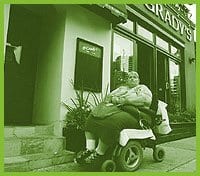The Church St neighbourhood may be a great place to live if you’re queer, but it’s not so easy if you’re living with a disability.
That’s what Maria Cortez and Lloyd Preston are finding. Both use wheelchairs and frequent the Church-Wellesley Village neighbourhood. While they say there have always been challenges, they’re frustrated that with all the recent changes to the local businesses wheelchair accessibility doesn’t seem to be a priority.
“You’re essentially excluding people who want to be part of the gay community,” says Preston. “People want to socialize with their community. People shouldn’t be excluded by a single step.”
Two new businesses, The Churchmouse And The Firkin and O’Grady’s, continue to be inaccessible to people in wheelchairs; new management didn’t fix the long-term problem. The Second Cup at 546 Church St and the former Body Shop location at 77 Wellesley St, now Lettieri, both used to have ramps in addition to stairs, but both were renovated – at least initially – without maintaining the previous level of accessibility.
“There’s not enough accessibility as it is, and you’re taking away what is there…. I feel people with disabilities are being slighted,” says Cortez. “I can’t get into one club, not a one. I would love to see shows in the area, but I can’t.”
A revised building plan that reintroduces a ramp leading to the Second Cup and other storefront businesses in the Village Centre has been submitted and is currently awaiting approval.
While temporary ramps have been installed at Lettieri and Churchmouse, Cortez says that in both cases they came as a result of her repeated suggestion. She doesn’t believe that the ramps would have been built without her pestering.
“The restaurants that are accessible are because I’ve been bugging them for years,” she says.
Ash Bhimani, owner of Lettieri, says that The Body Shop had only a temporary ramp that had to be removed during renovations. A new temporary ramp has since been installed, although Bhimani notes that he wasn’t obligated by any regulations to have one. “It wasn’t required by the design because it was a grandfather building,” he says. “We built it for our customers.”
Which buildings must be accessible, which are exempt and what counts as accessible in Toronto is fuzzy. The Ontario Building Code (OBC) was created by the province but is implemented by municipalities. Since 1986, all new buildings have been required to have barrier- free entrances and entrance-storey levels, but there are many exceptions including those for single homes.
Moreover, buildings that went up before 1986 are obliged to improve accessibility only if they are undergoing extensive renovations that includes the buildings’ entranceways, which means it’ll be a very long time before the majority of buildings are accessible.
“When you change something in the building code, not every business has to go out and change to fit the new standard,” explains Cengiz Kahramanoglu, a code advisor for the OBC.
In 2002, the Ontarians With Disabilities Act (ODA) was passed. It addresses the issues of accessibility and preexisting structures, but puts the onus on the municipalities to create their own accessibility plans.
Bernita Lee, a diversity management consultant with the City Of Toronto, says the city gets no resources from the province to implement these changes, nor can they mandate other businesses to become accessible. She says it would be up to the provincial government to take that step.
“We really need the province to step to the front and say we will make the ODA mandatory to private businesses, but that won’t happen in my lifetime,” says Lee. “The province would be shooting themselves in the foot.”
At present there is nothing mandating businesses to provide barrier-free access, and there are no resources for improvement, says Lee. If it was mandated, it would cost a lot and people would expect the province to help pay.
The majority of buildings along Church St are old enough that the OBC does not apply to them. And because most of them are privately owned they don’t fall under the City Of Toronto’s new accessibility guidelines, launched in June, that are to be enforced within all municipal buildings and facilities.
In other words, any changes that are made to create accessible areas along Church St will have to be voluntary.
“We have a lot of icing and not much cake in terms of disabled policy,” says Preston.
Preston would like to see a group formed in the Church St neighbourhood to look out for accessibility issues. “I think we’ll only get a response with collective action,” he says.
Cortez has called various city advisory committees and diversity management groups to lobby for changes. She points out that besides people who are in wheelchairs there are many seniors, strollers and people living in nearby hospices and assisted living facilities that need ramps, too.
“It’s the not caring that really bothers me,” says Cortez. “They don’t need our money, we’re just second-class citizens.”

 Why you can trust Xtra
Why you can trust Xtra


